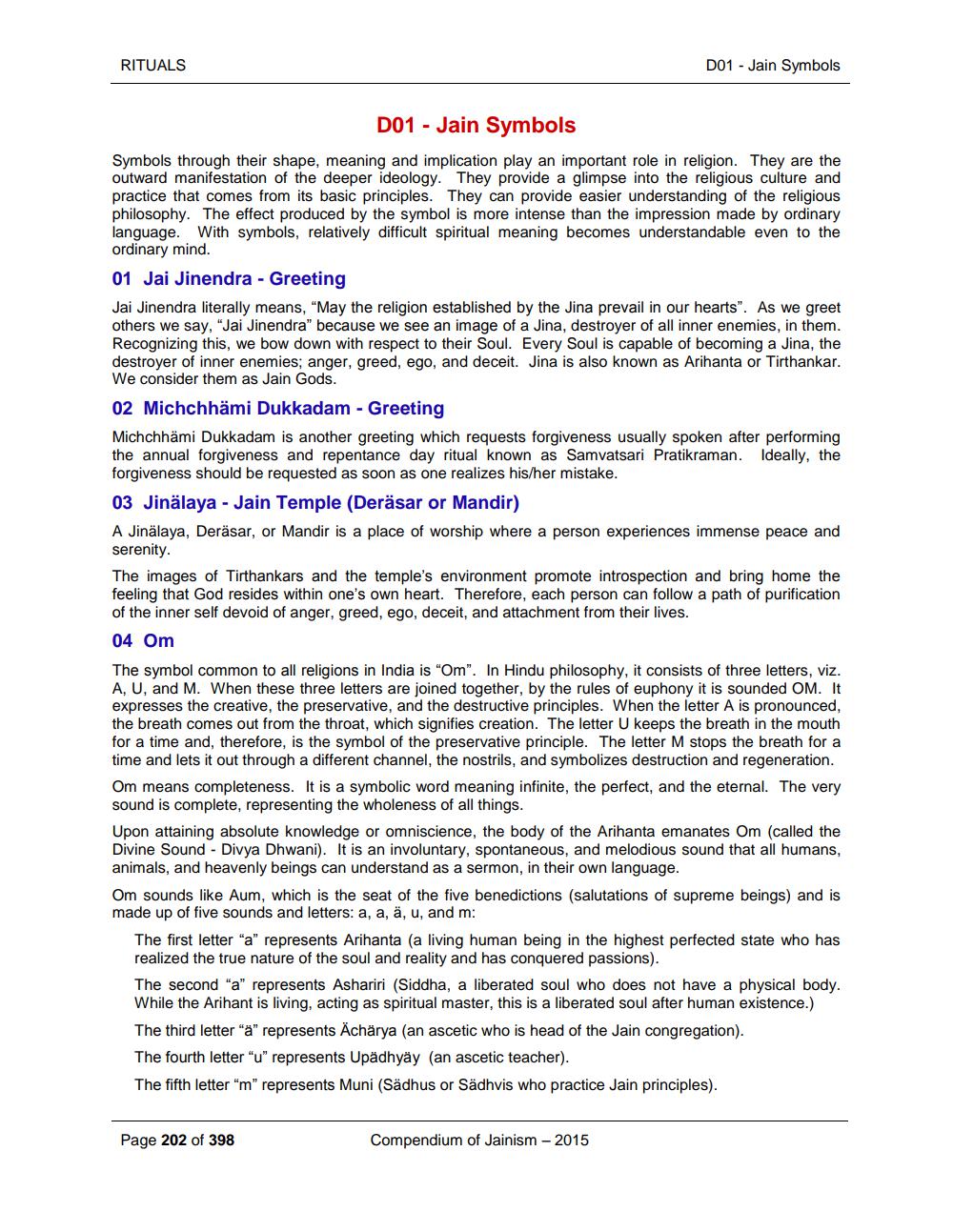________________
RITUALS
D01 - Jain Symbols
D01 - Jain Symbols
Symbols through their shape, meaning and implication play an important role in religion. They are the outward manifestation of the deeper ideology. They provide a glimpse into the religious culture and practice that comes from its basic principles. They can provide easier understanding of the religious philosophy. The effect produced by the symbol is more intense than the impression made by ordinary language. With symbols, relatively difficult spiritual meaning becomes understandable even to the ordinary mind. 01 Jai Jinendra - Greeting Jai Jinendra literally means, "May the religion established by the Jina prevail in our hearts". As we greet others we say, "Jai Jinendra" because we see an image of a Jina, destroyer of all inner enemies, in them. Recognizing this, we bow down with respect to their Soul. Every Soul is capable of becoming a Jina, the destroyer of inner enemies; anger, greed, ego, and deceit. Jina is also known as Arihanta or Tirthankar. We consider them as Jain Gods. 02 Michchhami Dukkadam - Greeting Michchhami Dukkadam is another greeting which requests forgiveness usually spoken after performing the annual forgiveness and repentance day ritual known as Samvatsari Pratikraman. Ideally, the forgiveness should be requested as soon as one realizes his/her mistake. 03 Jinälaya - Jain Temple (Deräsar or Mandir) A Jinälaya, Deräsar, or Mandir is a place of worship where a person experiences immense peace and serenity. The images of Tirthankars and the temple's environment promote introspection and bring home the feeling that God resides within one's own heart. Therefore, each person can follow a path of purification of the inner self devoid of anger, greed, ego, deceit, and attachment from their lives. 04 Om The symbol common to all religions in India is "Om". In Hindu philosophy, it consists of three letters, viz. A, U, and M. When these three letters are joined together, by the rules of euphony it is sounded OM. It expresses the creative, the preservative, and the destructive principles. When the letter A is pronounced, the breath comes out from the throat, which signifies creation. The letter U keeps the breath in the mouth for a time and, therefore, is the symbol of the preservative principle. The letter M stops the breath for a time and lets it out through a different channel, the nostrils, and symbolizes destruction and regeneration. Om means completeness. It is a symbolic word meaning infinite, the perfect, and the eternal. The very sound is complete, representing the wholeness of all things. Upon attaining absolute knowledge or omniscience, the body of the Arihanta emanates Om (called the Divine Sound - Divya Dhwani). It is an involuntary, spontaneous, and melodious sound that all humans, animals, and heavenly beings can understand as a sermon, in their own language. Om sounds like Aum, which is the seat of the five benedictions (salutations of supreme beings) and is made up of five sounds and letters: a, a, a, u, and m:
The first letter "a" represents Arihanta (a living human being in the highest perfected state who has realized the true nature of the soul and reality and has conquered passions). The second "a" represents Ashariri (Siddha, a liberated soul who does not have a physical body. While the Arihant is living, acting as spiritual master, this is a liberated soul after human existence.) The third letter "a" represents Acharya (an ascetic who is head of the Jain congregation). The fourth letter "u" represents Upadhyay (an ascetic teacher). The fifth letter "m" represents Muni (Sädhus or Sädhvis who practice Jain principles).
Page 202 of 398
Compendium of Jainism - 2015




